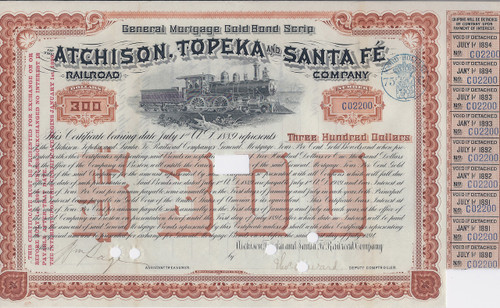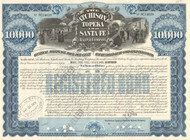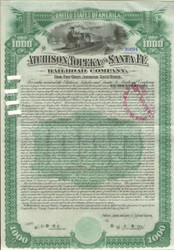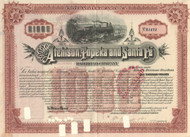Categories
Categories
- Home
- Railroad
- 1800's Railroads
- Atchison, Topeka, and Santa Fe RR Scrip 1894
Atchison, Topeka, and Santa Fe RR Scrip 1894
Product Description
Atchison, Topeka, and Santa Fe Railroad scrip (1894)
This smaller stock-sized gold bond scrip certificate is a rare find! Great vignette of a smoking steam engine and tender. Coupons attached to the right. 1894 Small holes in denomination and signatures. Great collectible for the rail fan or model train enthusiast.
The Atchison, Topeka and Santa Fe Railway (ATSF), often abbreviated to Santa Fe or AT&SF, was one of the larger railroads in the United States. Chartered in February 1859, the railroad reached the Kansas-Colorado border in 1873 and Pueblo, Colorado, in 1876. To create a demand for its services, the railroad set up real estate offices and sold farm land from the land grants that it was awarded by Congress. Despite the name, its main line never served Santa Fe, New Mexico, as the terrain was too difficult.
The Santa Fe was a pioneer in intermodal freight service, an enterprise that, at one time, included a tugboat fleet and an airline (Santa Fe Skyway). Its bus line extended passenger transportation to areas not accessible by rail, and ferryboats on the San Francisco Bay allowed travelers to complete their westward journeys to the Pacific Ocean. The ATSF was the subject of a popular song, Harry Warren & Johnny Mercer's "On the Atchison, Topeka and the Santa Fe", written for the film, The Harvey Girls (1946). The railroad was known for its passenger trains, notably the Chicago-Los Angeles El Capitan and Super Chief, currently operated as Amtrak's Southwest Chief.
The railroad officially ceased operations on December 31, 1996, when it merged with the Burlington Northern Railroad to form the Burlington Northern & Santa Fe Railway.
The Atchison, Topeka & Santa Fe Railway (AT&SF) was chartered on February 11, 1859, to join Atchison and Topeka, Kansas, with Santa Fe, New Mexico. In its early years, the railroad opened Kansas to settlement. Much of its revenue came from wheat grown there and from cattle driven north from Texas to Wichita and Dodge City by September 1872.
Building across Kansas and eastern Colorado was simple, with few natural obstacles but the railroad found it almost economically impossible because of the sparse population. It set up real estate offices in the area and promoted settlement across Kansas on the land that was granted to it by Congress in 1863.
AT&SF reached Albuquerque in 1880; Santa Fe, the original destination of the railroad, found itself on a short branch from Lamy, New Mexico. In March 1881 AT&SF connected with the Southern Pacific (SP) at Deming, New Mexico, forming the second transcontinental rail route. The railroad then built southwest from Benson, Arizona, to Nogales on the Mexican border where it connected with the Sonora Railway, which the AT&SF had built north from the Mexican port of Guaymas.
The Atlantic & Pacific Railroad (A&P) was chartered in 1866 to build west from Springfield, Missouri, along the 35th parallel of latitude to a junction with SP at the Colorado River. The infant A&P had no rail connections. The line that was to become the St. Louis–San Francisco Railway (Frisco) would not reach Springfield for another four years, and SP did not build east from Mojave to the Colorado River until 1883. A&P started construction in 1868, built southwest into what would become Oklahoma, and promptly entered receivership.
In 1879 A&P struck a deal with the Santa Fe and Frisco railroads to construct a rail line for each. The railroads would jointly build and own the A&P railroad west of Albuquerque. In 1883 A&P reached Needles, California, where it connected with an SP line.
AT&SF still wanted to reach California on its own rails and the state of California eagerly courted the railroad to break SP's monopoly. In 1897 the railroad traded the Sonora Railway of Mexico to SP for their line between Barstow and Mojave, giving AT&SF its own line from Chicago to the Pacific coast.
The Panic of 1893 had the same effect on the AT&SF that it had on many other railroads; financial problems and subsequent reorganization. In 1895 AT&SF sold the Frisco and the Colorado Midland and wrote off the losses, but it still retained control of the A&P. In 1907, AT&SF and SP jointly formed the Northwestern Pacific Railroad (NWP), which took over several short railroads and built new lines connecting them to form a route from San Francisco north to Eureka, California. In 1928, Santa Fe sold its half of NWP to SP.
In 1960, AT&SF bought the Toledo, Peoria & Western Railroad (TP&W), then sold a half interest to the Pennsylvania Railroad (PRR). The TP&W route did not mesh with the traffic pattern PRR successor Conrail developed after 1976, so AT&SF bought back the other half, merged with TP&W in 1983, then sold it back into independence in 1989. On September 22, 1995, AT&SF and SP merged with Burlington Northern Inc. to form the Burlington Northern & Santa Fe Railway (BNSF).
 Loading... Please wait...
Loading... Please wait... 








